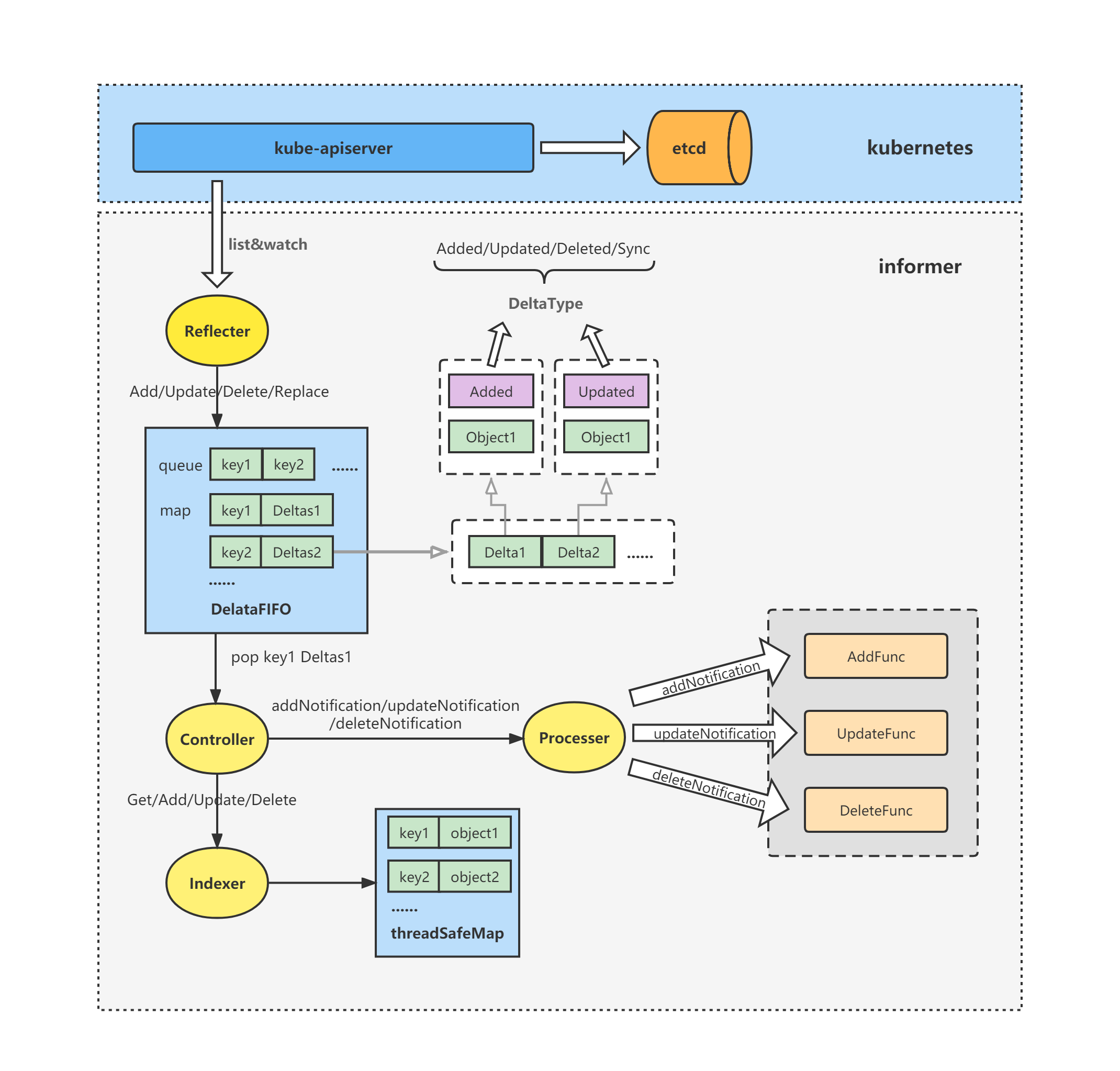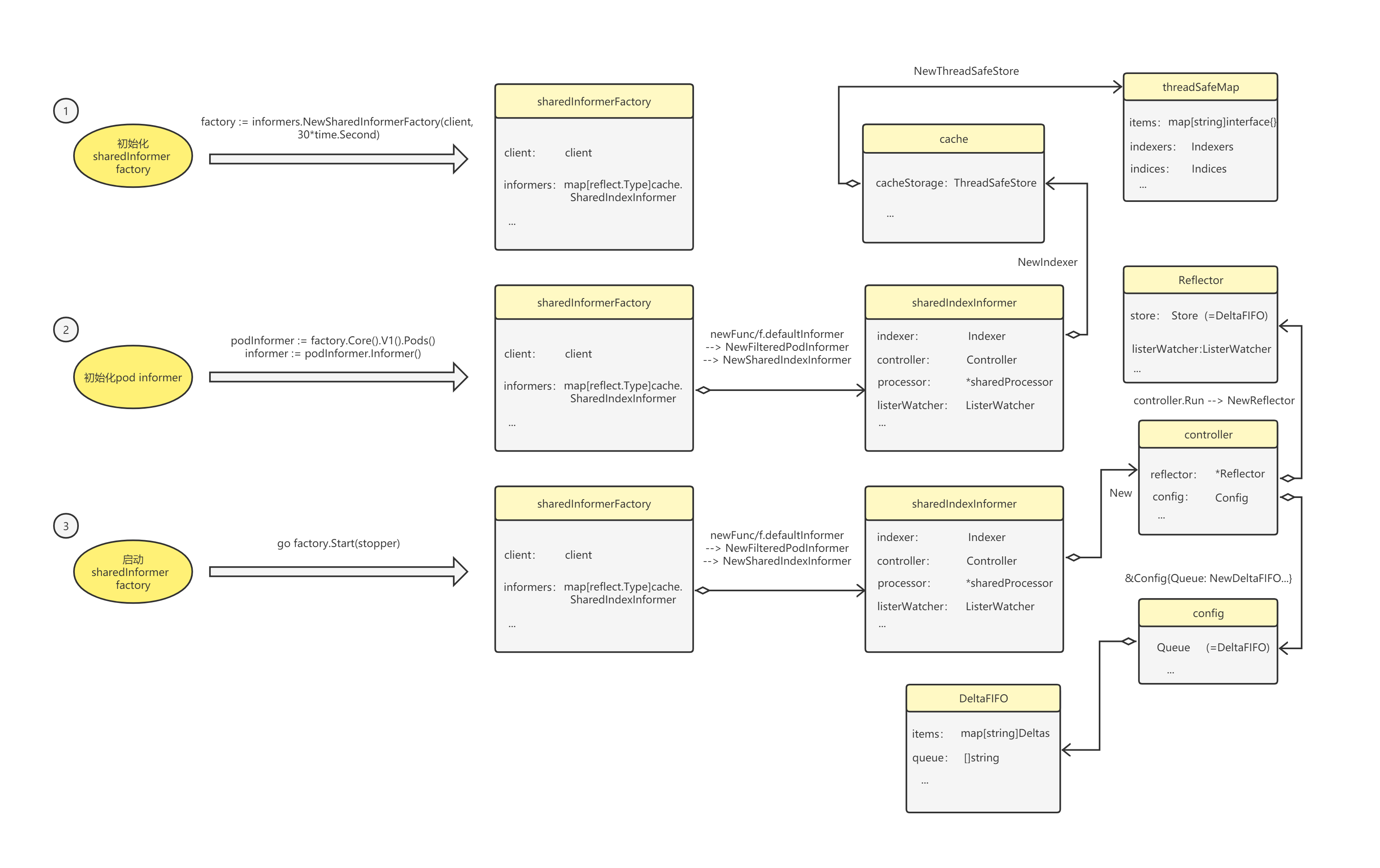k8s client-go源码分析 informer源码分析(2)-初始化与启动分析
k8s client-go源码分析 informer源码分析(2)-初始化与启动分析
前面一篇文章对k8s informer做了概要分析,本篇文章将对informer的初始化与启动进行分析。
informer架构
先来回忆一下informer的架构。

k8s client-go informer主要包括以下部件:
(1)Reflector:Reflector从kube-apiserver中list&watch资源对象,然后调用DeltaFIFO的Add/Update/Delete/Replace方法将资源对象及其变化包装成Delta并将其丢到DeltaFIFO中;
(2)DeltaFIFO:DeltaFIFO中存储着一个map和一个queue,即map[object key]Deltas以及object key的queue,Deltas为Delta的切片类型,Delta装有对象及对象的变化类型(Added/Updated/Deleted/Sync) ,Reflector负责DeltaFIFO的输入,Controller负责处理DeltaFIFO的输出;
(3)Controller:Controller从DeltaFIFO的queue中pop一个object key出来,并获取其关联的 Deltas出来进行处理,遍历Deltas,根据对象的变化更新Indexer中的本地内存缓存,并通知Processor,相关对象有变化事件发生;
(4)Processor:Processor根据对象的变化事件类型,调用相应的ResourceEventHandler来处理对象的变化;
(5)Indexer:Indexer中有informer维护的指定资源对象的相对于etcd数据的一份本地内存缓存,可通过该缓存获取资源对象,以减少对apiserver、对etcd的请求压力;
(6)ResourceEventHandler:用户根据自身处理逻辑需要,注册自定义的的ResourceEventHandler,当对象发生变化时,将触发调用对应类型的ResourceEventHandler来做处理。
概述
...
factory := informers.NewSharedInformerFactory(client, 30*time.Second)
podInformer := factory.Core().V1().Pods()
informer := podInformer.Informer()
...
go factory.Start(stopper)
...
if !cache.WaitForCacheSync(stopper, informer.HasSynced) {
runtime.HandleError(fmt.Errorf("Timed out waiting for caches to sync"))
return
}
...
上一节有列举了informer的使用代码,注意看到示例代码中的下面这段代码,做了informer初始化与启动,其中包括:
(1)informers.NewSharedInformerFactory:初始化informer factory;
(2)podInformer.Informer:初始化pod informer;
(3)factory.Start:启动informer factory;
(4)cache.WaitForCacheSync:等待list操作获取到的对象都同步到informer本地缓存Indexer中;
下面也将根据这四部分进行informer的初始化与启动分析。
基于k8s v1.17.4版本依赖的client-go
1.SharedInformerFactory的初始化
1.1 sharedInformerFactory结构体
先来看下sharedInformerFactory结构体,看下里面有哪些属性。
看到几个比较重要的属性:
(1)client:连接k8s的clientSet;
(2)informers:是个map,可以装各个对象的informer;
(3)startedInformers:记录已经启动的informer;
// staging/src/k8s.io/client-go/informers/factory.go
type sharedInformerFactory struct {
client kubernetes.Interface
namespace string
tweakListOptions internalinterfaces.TweakListOptionsFunc
lock sync.Mutex
defaultResync time.Duration
customResync map[reflect.Type]time.Duration
informers map[reflect.Type]cache.SharedIndexInformer
// startedInformers is used for tracking which informers have been started.
// This allows Start() to be called multiple times safely.
startedInformers map[reflect.Type]bool
}
1.2 NewSharedInformerFactory
NewSharedInformerFactory方法用于初始化informer factory,主要是初始化并返回sharedInformerFactory结构体。
// staging/src/k8s.io/client-go/informers/factory.go
func NewSharedInformerFactory(client kubernetes.Interface, defaultResync time.Duration) SharedInformerFactory {
return NewSharedInformerFactoryWithOptions(client, defaultResync)
}
func NewFilteredSharedInformerFactory(client kubernetes.Interface, defaultResync time.Duration, namespace string, tweakListOptions internalinterfaces.TweakListOptionsFunc) SharedInformerFactory {
return NewSharedInformerFactoryWithOptions(client, defaultResync, WithNamespace(namespace), WithTweakListOptions(tweakListOptions))
}
func NewSharedInformerFactoryWithOptions(client kubernetes.Interface, defaultResync time.Duration, options ...SharedInformerOption) SharedInformerFactory {
factory := &sharedInformerFactory{
client: client,
namespace: v1.NamespaceAll,
defaultResync: defaultResync,
informers: make(map[reflect.Type]cache.SharedIndexInformer),
startedInformers: make(map[reflect.Type]bool),
customResync: make(map[reflect.Type]time.Duration),
}
// Apply all options
for _, opt := range options {
factory = opt(factory)
}
return factory
}
2.对象informer的初始化
上一节有列举了informer的使用代码,注意看到示例代码中的下面这段代码,这里利用了工厂方法设计模式,podInformer.Informer()即初始化了sharedInformerFactory中的pod的informer,具体调用关系可自行看如下代码,比较简单,这里不再展开分析。
// 初始化informer factory以及pod informer
factory := informers.NewSharedInformerFactory(client, 30*time.Second)
podInformer := factory.Core().V1().Pods()
informer := podInformer.Informer()
2.1 podInformer.Informer
Informer方法中调用了f.factory.InformerFor方法来做pod informer的初始化。
// k8s.io/client-go/informers/core/v1/pod.go
func (f *podInformer) Informer() cache.SharedIndexInformer {
return f.factory.InformerFor(&corev1.Pod{}, f.defaultInformer)
}
2.2 f.factory.InformerFor
Informer方法中调用了f.factory.InformerFor方法来做pod informer的初始化,并传入f.defaultInformer作为newFunc,而在f.factory.InformerFor方法中,调用newFunc来初始化informer。
这里也可以看到,其实informer初始化后会存储进map f.informers[informerType]中,即存储进sharedInformerFactory结构体的informers属性中,方便共享使用。
// staging/src/k8s.io/client-go/informers/factory.go
func (f *sharedInformerFactory) InformerFor(obj runtime.Object, newFunc internalinterfaces.NewInformerFunc) cache.SharedIndexInformer {
f.lock.Lock()
defer f.lock.Unlock()
informerType := reflect.TypeOf(obj)
informer, exists := f.informers[informerType]
if exists {
return informer
}
resyncPeriod, exists := f.customResync[informerType]
if !exists {
resyncPeriod = f.defaultResync
}
informer = newFunc(f.client, resyncPeriod)
f.informers[informerType] = informer
return informer
}
2.3 newFunc/f.defaultInformer
defaultInformer方法中,调用了NewFilteredPodInformer方法来初始化pod informer,最终初始化并返回sharedIndexInformer结构体。
// k8s.io/client-go/informers/core/v1/pod.go
func (f *podInformer) defaultInformer(client kubernetes.Interface, resyncPeriod time.Duration) cache.SharedIndexInformer {
return NewFilteredPodInformer(client, f.namespace, resyncPeriod, cache.Indexers{cache.NamespaceIndex: cache.MetaNamespaceIndexFunc}, f.tweakListOptions)
}
func NewFilteredPodInformer(client kubernetes.Interface, namespace string, resyncPeriod time.Duration, indexers cache.Indexers, tweakListOptions internalinterfaces.TweakListOptionsFunc) cache.SharedIndexInformer {
return cache.NewSharedIndexInformer(
&cache.ListWatch{
ListFunc: func(options metav1.ListOptions) (runtime.Object, error) {
if tweakListOptions != nil {
tweakListOptions(&options)
}
return client.CoreV1().Pods(namespace).List(options)
},
WatchFunc: func(options metav1.ListOptions) (watch.Interface, error) {
if tweakListOptions != nil {
tweakListOptions(&options)
}
return client.CoreV1().Pods(namespace).Watch(options)
},
},
&corev1.Pod{},
resyncPeriod,
indexers,
)
}
func NewSharedIndexInformer(lw ListerWatcher, objType runtime.Object, defaultEventHandlerResyncPeriod time.Duration, indexers Indexers) SharedIndexInformer {
realClock := &clock.RealClock{}
sharedIndexInformer := &sharedIndexInformer{
processor: &sharedProcessor{clock: realClock},
indexer: NewIndexer(DeletionHandlingMetaNamespaceKeyFunc, indexers),
listerWatcher: lw,
objectType: objType,
resyncCheckPeriod: defaultEventHandlerResyncPeriod,
defaultEventHandlerResyncPeriod: defaultEventHandlerResyncPeriod,
cacheMutationDetector: NewCacheMutationDetector(fmt.Sprintf("%T", objType)),
clock: realClock,
}
return sharedIndexInformer
}
2.4 sharedIndexInformer结构体
sharedIndexInformer结构体中重点看到以下几个属性:
(1)indexer:对应着informer中的部件Indexer,Indexer中有informer维护的指定资源对象的相对于etcd数据的一份本地内存缓存,可通过该缓存获取资源对象,以减少对apiserver、对etcd的请求压力;
(2)controller:对应着informer中的部件Controller,Controller从DeltaFIFO中pop Deltas出来处理,根据对象的变化更新Indexer中的本地内存缓存,并通知Processor,相关对象有变化事件发生;
(3)processor:对应着informer中的部件Processor,Processor根据对象的变化事件类型,调用相应的ResourceEventHandler来处理对象的变化;
// staging/src/k8s.io/client-go/tools/cache/shared_informer.go
type sharedIndexInformer struct {
indexer Indexer
controller Controller
processor *sharedProcessor
cacheMutationDetector CacheMutationDetector
// This block is tracked to handle late initialization of the controller
listerWatcher ListerWatcher
objectType runtime.Object
// resyncCheckPeriod is how often we want the reflector's resync timer to fire so it can call
// shouldResync to check if any of our listeners need a resync.
resyncCheckPeriod time.Duration
// defaultEventHandlerResyncPeriod is the default resync period for any handlers added via
// AddEventHandler (i.e. they don't specify one and just want to use the shared informer's default
// value).
defaultEventHandlerResyncPeriod time.Duration
// clock allows for testability
clock clock.Clock
started, stopped bool
startedLock sync.Mutex
// blockDeltas gives a way to stop all event distribution so that a late event handler
// can safely join the shared informer.
blockDeltas sync.Mutex
}
Indexer接口与cache结构体
cache结构体为Indexer接口的实现;
// staging/src/k8s.io/client-go/tools/cache/store.go
type cache struct {
cacheStorage ThreadSafeStore
keyFunc KeyFunc
}
threadSafeMap struct是ThreadSafeStore接口的一个实现,其最重要的一个属性便是items了,items是用map构建的键值对,资源对象都存在items这个map中,key根据资源对象来算出,value为资源对象本身,这里的items即为informer的本地缓存了,而indexers与indices属性则与索引功能有关。
// staging/src/k8s.io/client-go/tools/cache/thread_safe_store.go
type threadSafeMap struct {
lock sync.RWMutex
items map[string]interface{}
// indexers maps a name to an IndexFunc
indexers Indexers
// indices maps a name to an Index
indices Indices
}
关于Indexer的详细分析会在后续有专门的文章做分析,这里不展开分析;
controller结构体
而controller结构体则包含了informer中的主要部件Reflector以及DeltaFIFO;
(1)Reflector:Reflector从kube-apiserver中list&watch资源对象,然后将对象的变化包装成Delta并将其丢到DeltaFIFO中;
(2)DeltaFIFO:DeltaFIFO存储着map[object key]Deltas以及object key的queue,Delta装有对象及对象的变化类型 ,Reflector负责DeltaFIFO的输入,Controller负责处理DeltaFIFO的输出;
// staging/src/k8s.io/client-go/tools/cache/controller.go
type controller struct {
config Config
reflector *Reflector
reflectorMutex sync.RWMutex
clock clock.Clock
}
type Config struct {
// The queue for your objects; either a FIFO or
// a DeltaFIFO. Your Process() function should accept
// the output of this Queue's Pop() method.
Queue
...
}
3.启动sharedInformerFactory
sharedInformerFactory.Start为informer factory的启动方法,其主要逻辑为循环遍历informers,然后跑goroutine调用informer.Run来启动sharedInformerFactory中存储的各个informer。
// staging/src/k8s.io/client-go/informers/factory.go
func (f *sharedInformerFactory) Start(stopCh <-chan struct{}) {
f.lock.Lock()
defer f.lock.Unlock()
for informerType, informer := range f.informers {
if !f.startedInformers[informerType] {
go informer.Run(stopCh)
f.startedInformers[informerType] = true
}
}
}
sharedIndexInformer.Run
sharedIndexInformer.Run用于启动informer,主要逻辑为:
(1)调用NewDeltaFIFO,初始化DeltaFIFO;
(2)构建Config结构体,这里留意下Process属性,赋值了s.HandleDeltas,后面会分析到该方法;
(3)调用New,利用Config结构体来初始化controller;
(4)调用s.processor.run,启动processor;
(5)调用s.controller.Run,启动controller;
// staging/src/k8s.io/client-go/tools/cache/shared_informer.go
func (s *sharedIndexInformer) Run(stopCh <-chan struct{}) {
defer utilruntime.HandleCrash()
// 初始化DeltaFIFO
fifo := NewDeltaFIFO(MetaNamespaceKeyFunc, s.indexer)
// 构建Config结构体
cfg := &Config{
Queue: fifo,
ListerWatcher: s.listerWatcher,
ObjectType: s.objectType,
FullResyncPeriod: s.resyncCheckPeriod,
RetryOnError: false,
ShouldResync: s.processor.shouldResync,
Process: s.HandleDeltas,
}
func() {
s.startedLock.Lock()
defer s.startedLock.Unlock()
// 初始化controller
s.controller = New(cfg)
s.controller.(*controller).clock = s.clock
s.started = true
}()
// Separate stop channel because Processor should be stopped strictly after controller
processorStopCh := make(chan struct{})
var wg wait.Group
defer wg.Wait() // Wait for Processor to stop
defer close(processorStopCh) // Tell Processor to stop
wg.StartWithChannel(processorStopCh, s.cacheMutationDetector.Run)
// 启动processor
wg.StartWithChannel(processorStopCh, s.processor.run)
defer func() {
s.startedLock.Lock()
defer s.startedLock.Unlock()
s.stopped = true // Don't want any new listeners
}()
// 启动controller
s.controller.Run(stopCh)
}
3.1 New
New函数初始化了controller并return。
// staging/src/k8s.io/client-go/tools/cache/controller.go
func New(c *Config) Controller {
ctlr := &controller{
config: *c,
clock: &clock.RealClock{},
}
return ctlr
}
3.2 s.processor.run
s.processor.run启动了processor,其中注意到listener.run与listener.pop两个核心方法即可,暂时没有用到,等下面用到他们的时候再做分析。
// staging/src/k8s.io/client-go/tools/cache/shared_informer.go
func (p *sharedProcessor) run(stopCh <-chan struct{}) {
func() {
p.listenersLock.RLock()
defer p.listenersLock.RUnlock()
for _, listener := range p.listeners {
p.wg.Start(listener.run)
p.wg.Start(listener.pop)
}
p.listenersStarted = true
}()
<-stopCh
p.listenersLock.RLock()
defer p.listenersLock.RUnlock()
for _, listener := range p.listeners {
close(listener.addCh) // Tell .pop() to stop. .pop() will tell .run() to stop
}
p.wg.Wait() // Wait for all .pop() and .run() to stop
}
3.3 controller.Run
controller.Run为controller的启动方法,这里主要看到几个点:
(1)调用NewReflector,初始化Reflector;
(2)调用r.Run,实际上是调用了Reflector的启动方法来启动Reflector;
(3)调用c.processLoop,开始controller的核心处理;
// k8s.io/client-go/tools/cache/controller.go
func (c *controller) Run(stopCh <-chan struct{}) {
defer utilruntime.HandleCrash()
go func() {
<-stopCh
c.config.Queue.Close()
}()
r := NewReflector(
c.config.ListerWatcher,
c.config.ObjectType,
c.config.Queue,
c.config.FullResyncPeriod,
)
r.ShouldResync = c.config.ShouldResync
r.clock = c.clock
c.reflectorMutex.Lock()
c.reflector = r
c.reflectorMutex.Unlock()
var wg wait.Group
defer wg.Wait()
wg.StartWithChannel(stopCh, r.Run)
wait.Until(c.processLoop, time.Second, stopCh)
}
3.3.1 Reflector结构体
先来看到Reflector结构体,这里重点看到以下属性:
(1)expectedType:放到Store中(即DeltaFIFO中)的对象类型;
(2)store:store会赋值为DeltaFIFO,具体可以看之前的informer初始化与启动分析即可得知,这里不再展开分析;
(3)listerWatcher:存放list方法和watch方法的ListerWatcher interface实现;
// k8s.io/client-go/tools/cache/reflector.go
type Reflector struct {
...
expectedType reflect.Type
store Store
listerWatcher ListerWatcher
...
}
3.3.2 r.Run/Reflector.Run
Reflector.Run方法中启动了Reflector,而Reflector的核心处理逻辑为从kube-apiserver处做list&watch操作,然后将得到的对象封装存储进DeltaFIFO中。
// staging/src/k8s.io/client-go/tools/cache/reflector.go
func (r *Reflector) Run(stopCh <-chan struct{}) {
klog.V(3).Infof("Starting reflector %v (%s) from %s", r.expectedTypeName, r.resyncPeriod, r.name)
wait.Until(func() {
if err := r.ListAndWatch(stopCh); err != nil {
utilruntime.HandleError(err)
}
}, r.period, stopCh)
}
3.3.3 controller.processLoop
controller的核心处理方法processLoop中,最重要的逻辑是循环调用c.config.Queue.Pop将DeltaFIFO中的队头元素给pop出来,然后调用c.config.Process方法来做处理,当处理出错时,再调用c.config.Queue.AddIfNotPresent将对象重新加入到DeltaFIFO中去。
// k8s.io/client-go/tools/cache/controller.go
func (c *controller) processLoop() {
for {
obj, err := c.config.Queue.Pop(PopProcessFunc(c.config.Process))
if err != nil {
if err == ErrFIFOClosed {
return
}
if c.config.RetryOnError {
// This is the safe way to re-enqueue.
c.config.Queue.AddIfNotPresent(obj)
}
}
}
}
3.3.4 c.config.Process/sharedIndexInformer.HandleDeltas
根据前面sharedIndexInformer.Run方法的分析中可以得知,c.config.Process其实就是sharedIndexInformer.HandleDeltas。
HandleDeltas方法中,将从DeltaFIFO中pop出来的对象以及类型,相应的在indexer中做添加、更新、删除操作,并调用s.processor.distribute通知自定义的ResourceEventHandler。
// staging/src/k8s.io/client-go/tools/cache/shared_informer.go
func (s *sharedIndexInformer) HandleDeltas(obj interface{}) error {
s.blockDeltas.Lock()
defer s.blockDeltas.Unlock()
// from oldest to newest
for _, d := range obj.(Deltas) {
switch d.Type {
case Sync, Added, Updated:
isSync := d.Type == Sync
s.cacheMutationDetector.AddObject(d.Object)
if old, exists, err := s.indexer.Get(d.Object); err == nil && exists {
if err := s.indexer.Update(d.Object); err != nil {
return err
}
s.processor.distribute(updateNotification{oldObj: old, newObj: d.Object}, isSync)
} else {
if err := s.indexer.Add(d.Object); err != nil {
return err
}
s.processor.distribute(addNotification{newObj: d.Object}, isSync)
}
case Deleted:
if err := s.indexer.Delete(d.Object); err != nil {
return err
}
s.processor.distribute(deleteNotification{oldObj: d.Object}, false)
}
}
return nil
}
怎么通知到自定义的ResourceEventHandler呢?继续往下看。
3.3.5 sharedIndexInformer.processor.distribute
可以看到distribute方法最终是将构造好的addNotification、updateNotification、deleteNotification对象写入到p.addCh中。
// staging/src/k8s.io/client-go/tools/cache/shared_informer.go
func (p *sharedProcessor) distribute(obj interface{}, sync bool) {
p.listenersLock.RLock()
defer p.listenersLock.RUnlock()
if sync {
for _, listener := range p.syncingListeners {
listener.add(obj)
}
} else {
for _, listener := range p.listeners {
listener.add(obj)
}
}
}
func (p *processorListener) add(notification interface{}) {
p.addCh <- notification
}
到这里,processor中的listener.pop以及listener.run方法终于派上了用场,继续往下看。
3.3.6 listener.pop
分析processorListener的pop方法可以得知,其逻辑实际上就是将p.addCh中的对象给拿出来,然后丢进了p.nextCh中。那么谁来处理p.nextCh呢?继续往下看。
// staging/src/k8s.io/client-go/tools/cache/shared_informer.go
func (p *processorListener) pop() {
defer utilruntime.HandleCrash()
defer close(p.nextCh) // Tell .run() to stop
var nextCh chan<- interface{}
var notification interface{}
for {
select {
case nextCh <- notification:
// Notification dispatched
var ok bool
notification, ok = p.pendingNotifications.ReadOne()
if !ok { // Nothing to pop
nextCh = nil // Disable this select case
}
case notificationToAdd, ok := <-p.addCh:
if !ok {
return
}
if notification == nil { // No notification to pop (and pendingNotifications is empty)
// Optimize the case - skip adding to pendingNotifications
notification = notificationToAdd
nextCh = p.nextCh
} else { // There is already a notification waiting to be dispatched
p.pendingNotifications.WriteOne(notificationToAdd)
}
}
}
}
3.3.7 listener.run
在processorListener的run方法中,将循环读取p.nextCh,判断对象类型,是updateNotification则调用p.handler.OnUpdate方法,是addNotification则调用p.handler.OnAdd方法,是deleteNotification则调用p.handler.OnDelete方法做处理。
// staging/src/k8s.io/client-go/tools/cache/shared_informer.go
func (p *processorListener) run() {
// this call blocks until the channel is closed. When a panic happens during the notification
// we will catch it, **the offending item will be skipped!**, and after a short delay (one second)
// the next notification will be attempted. This is usually better than the alternative of never
// delivering again.
stopCh := make(chan struct{})
wait.Until(func() {
// this gives us a few quick retries before a long pause and then a few more quick retries
err := wait.ExponentialBackoff(retry.DefaultRetry, func() (bool, error) {
for next := range p.nextCh {
switch notification := next.(type) {
case updateNotification:
p.handler.OnUpdate(notification.oldObj, notification.newObj)
case addNotification:
p.handler.OnAdd(notification.newObj)
case deleteNotification:
p.handler.OnDelete(notification.oldObj)
default:
utilruntime.HandleError(fmt.Errorf("unrecognized notification: %T", next))
}
}
// the only way to get here is if the p.nextCh is empty and closed
return true, nil
})
// the only way to get here is if the p.nextCh is empty and closed
if err == nil {
close(stopCh)
}
}, 1*time.Minute, stopCh)
}
而p.handler.OnUpdate、p.handler.OnAdd、p.handler.OnDelete方法实际上就是自定义的的ResourceEventHandlerFuncs了。
informer.AddEventHandler(cache.ResourceEventHandlerFuncs{
AddFunc: onAdd,
UpdateFunc: onUpdate,
DeleteFunc: onDelete,
})
// staging/src/k8s.io/client-go/tools/cache/controller.go
type ResourceEventHandlerFuncs struct {
AddFunc func(obj interface{})
UpdateFunc func(oldObj, newObj interface{})
DeleteFunc func(obj interface{})
}
func (r ResourceEventHandlerFuncs) OnAdd(obj interface{}) {
if r.AddFunc != nil {
r.AddFunc(obj)
}
}
func (r ResourceEventHandlerFuncs) OnUpdate(oldObj, newObj interface{}) {
if r.UpdateFunc != nil {
r.UpdateFunc(oldObj, newObj)
}
}
func (r ResourceEventHandlerFuncs) OnDelete(obj interface{}) {
if r.DeleteFunc != nil {
r.DeleteFunc(obj)
}
}
4.cache.WaitForCacheSync(stopper, informer.HasSynced)
可以看出在cache.WaitForCacheSync方法中,实际上是调用方法入参cacheSyncs ...InformerSynced来判断cache是否同步完成(即调用informer.HasSynced方法),而这里说的cache同步完成,意思是等待informer从kube-apiserver同步资源完成,即informer的list操作获取的对象都存入到informer中的indexer本地缓存中;
// staging/src/k8s.io/client-go/tools/cache/shared_informer.go
func WaitForCacheSync(stopCh <-chan struct{}, cacheSyncs ...InformerSynced) bool {
err := wait.PollImmediateUntil(syncedPollPeriod,
func() (bool, error) {
for _, syncFunc := range cacheSyncs {
if !syncFunc() {
return false, nil
}
}
return true, nil
},
stopCh)
if err != nil {
klog.V(2).Infof("stop requested")
return false
}
klog.V(4).Infof("caches populated")
return true
}
4.1 informer.HasSynced
HasSynced方法实际上是调用了sharedIndexInformer.controller.HasSynced方法;
// staging/src/k8s.io/client-go/tools/cache/shared_informer.go
func (s *sharedIndexInformer) HasSynced() bool {
s.startedLock.Lock()
defer s.startedLock.Unlock()
if s.controller == nil {
return false
}
return s.controller.HasSynced()
}
s.controller.HasSynced
这里的c.config.Queue.HasSynced()方法,实际上是指DeltaFIFO的HasSynced方法,会在DeltaFIFO的分析中再详细分析,这里只需要知道当informer的list操作获取的对象都存入到informer中的indexer本地缓存中则返回true即可;
// staging/src/k8s.io/client-go/tools/cache/controller.go
func (c *controller) HasSynced() bool {
return c.config.Queue.HasSynced()
}
4.2 sharedInformerFactory.WaitForCacheSync
可以顺带看下sharedInformerFactory.WaitForCacheSync方法,其实际上是遍历factory中的所有informer,调用cache.WaitForCacheSync,然后传入每个informer的HasSynced方法作为入参;
// staging/src/k8s.io/client-go/informers/factory.go
func (f *sharedInformerFactory) WaitForCacheSync(stopCh <-chan struct{}) map[reflect.Type]bool {
informers := func() map[reflect.Type]cache.SharedIndexInformer {
f.lock.Lock()
defer f.lock.Unlock()
informers := map[reflect.Type]cache.SharedIndexInformer{}
for informerType, informer := range f.informers {
if f.startedInformers[informerType] {
informers[informerType] = informer
}
}
return informers
}()
res := map[reflect.Type]bool{}
for informType, informer := range informers {
res[informType] = cache.WaitForCacheSync(stopCh, informer.HasSynced)
}
return res
}
至此,整个informer的初始化与启动的分析就结束了,后面会对informer中的各个核心部件进行详细分析,敬请期待。
总结
下面用两张图片总结一下informer的初始化与启动;
informer初始化

informer启动

k8s client-go源码分析 informer源码分析(2)-初始化与启动分析的更多相关文章
- k8s client-go源码分析 informer源码分析(1)-概要分析
k8s informer概述 我们都知道可以使用k8s的Clientset来获取所有的原生资源对象,那么怎么能持续的获取集群的所有资源对象,或监听集群的资源对象数据的变化呢?这里不需要轮询去不断执行L ...
- k8s client-go源码分析 informer源码分析(3)-Reflector源码分析
k8s client-go源码分析 informer源码分析(3)-Reflector源码分析 1.Reflector概述 Reflector从kube-apiserver中list&watc ...
- k8s client-go源码分析 informer源码分析(4)-DeltaFIFO源码分析
client-go之DeltaFIFO源码分析 1.DeltaFIFO概述 先从名字上来看,DeltaFIFO,首先它是一个FIFO,也就是一个先进先出的队列,而Delta代表变化的资源对象,其包含资 ...
- k8s client-go源码分析 informer源码分析(5)-Controller&Processor源码分析
client-go之Controller&Processor源码分析 1.controller与Processor概述 Controller Controller从DeltaFIFO中pop ...
- kube-scheduler源码分析(1)-初始化与启动分析
kube-scheduler源码分析(1)-初始化与启动分析 kube-scheduler简介 kube-scheduler组件是kubernetes中的核心组件之一,主要负责pod资源对象的调度工作 ...
- k8s replicaset controller分析(1)-初始化与启动分析
replicaset controller分析 replicaset controller简介 replicaset controller是kube-controller-manager组件中众多控制 ...
- k8s client-go源码分析 informer源码分析(6)-Indexer源码分析
client-go之Indexer源码分析 1.Indexer概述 Indexer中有informer维护的指定资源对象的相对于etcd数据的一份本地内存缓存,可通过该缓存获取资源对象,以减少对api ...
- Kubernetes client-go Informer 源码分析
概述ControllerController 的初始化Controller 的启动processLoopHandleDeltas()SharedIndexInformersharedIndexerIn ...
- external-provisioner源码分析(2)-main方法与Leader选举分析
更多ceph-csi其他源码分析,请查看下面这篇博文:kubernetes ceph-csi分析目录导航 external-provisioner源码分析(2)-main方法与Leader选举分析 本 ...
随机推荐
- django-debug-toolbar 开发利器的使用教程
django-debug-toolbar介绍 django-debug-toolbar 是一组可配置的面板,可显示有关当前请求/响应的各种调试信息,并在单击时显示有关面板内容的更多详细信息. 下载安装 ...
- redis持久存储RDB和AOF的区别及优缺点
1.前言 最近在项目中使用到Redis做缓存,方便多个业务进程之间共享数据.由于Redis的数据都存放在内存中,如果没有配置持久化,redis重启后数据就全丢失了,于是需要开启redis的持久化功能, ...
- springboot-mail发邮件,不需要邮件服务器
很简单 步骤走起-> 1.需要一个邮箱账号,我以163邮箱为例,先开启第三方服务后获得密码,后面用来邮箱登录 2.加入mail 依赖 3.properties配置账号和第三方服务密码(不是邮箱密 ...
- TCP 重传、滑动窗⼝、流量控制、拥塞控制
重传机制 TCP 会在以下两种情况发⽣超时重传: 数据包丢失 确认应答丢失 重传超时 重传超时是TCP协议保证数据可靠性的另一个重要机制,其原理是在发送某一个数据以后就开启一个计时器,在一定时间内如果 ...
- 使用el-tree-transfer的方式
1.首先在组件中引入el-tree-transfer 2.然后在template中使用注册后的组件 参数:title 说明:标题 类型:Array 必填:false 默认:["源列表&quo ...
- Android 预置APK
1. 预置apk,使其不可卸载 第一步: 在 "/vendor/huawei/packages/apps" 目录下创建一个对应名称的文件夹. 第二步: 将 ...
- 小程序colorui框架引入与使用
colorui是UI框架: 超好用的一款 小程序二维码体验: : 引入方式: 1.先去下载colorui https://github.com/weilanwl/ColorUI 把col ...
- scrapy爬虫简单案例(简单易懂 适合新手)
爬取所有的电影名字,类型,时间等信息 1.准备工作 爬取的网页 https://www.ddoutv.com/f/27-1.html 创建项目 win + R 打开cmd输入 scrapy start ...
- IDM调用参数
cmd调用IDM 基本命令: IDMan /d URL [/p 本地文件路径] [/f 本地文件名] [/q] [/h] [/n] [/a] 参数: 名称 作用 /d 下载文件的url /s 开始任务 ...
- JavaWeb知识梳理(可收藏)
**JavaWeb相关知识 ** 1.Servlet 1.1 Status Code(Http状态码) 1.1xx 请求信息 Http状态码 Http Status Code Http状态码含义中文说 ...
